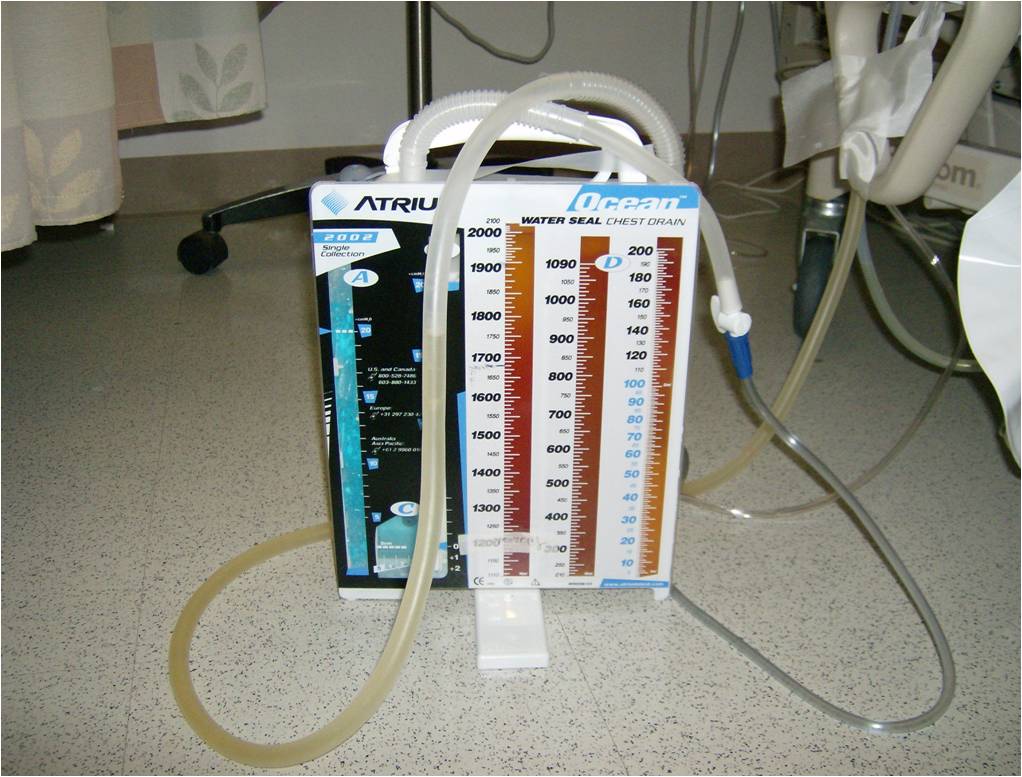The water seal chamber is a critical component of any chest drainage system. It serves to collect and hold the pleural effusion within the thoracic cavity as well as to prevent air from entering the pleural space. When an air leak occurs, it can be detected by continuous bubbling in the water seal chamber.
An air leak occurs when there is a break in the integrity of the chest wall or lung tissue, resulting in a tear or hole in the lung. This allows air to escape from the lungs and enter into the pleural space. The presence of an air leak can be determined by observing for constant bubbling in the water seal chamber. If this bubbling is present, then it indicates that there is an air leak present and requires further investigation.
In order to identify and manage an air leak, health care providers must be aware of certain techniques such as clamping off suction for one minute or inspecting connections from chest drainage unit to insertion site. Constant bubbling indicates that there is an air leak present and must be treated accordingly with appropriae interventions such as placing a Heimlich valve on the chest tube if needed or repairing a hole in the lung tissue if possible. It is also important for health care providers to recognize that normal tidaling—fluctuations in water-seal chamber with respiratory effort—occur during spontaneous inspiration and expiration which should not be mistaken for an air leak.
Overall, water seal chamber with continuous bubbling is indicative of an air leak which requires further intervention from healthcare professionals to prevent any further complications from occurring. It is essential that health care providers are familiar with these techniques so they can accurately assess for potential issues before they become serious health concerns for their patients.
Understanding the Meaning of Bubbling in the Water Seal
Bubbling in the water seal chamber is an indication of an air leak. This means that air has begun to seep into the chamber, which can lead to a pneumothorax (collapsed lung). In order to diagnose and treat this issue, medical professionals require reliable tools in order to make informed decisions and take necessary action.

Troubleshooting a Bubbling Water Seal
If you observe bubbling in the water-seal chamber of the drainage system, it likely indicates a leak. First, check for any external leaks and attempt to identify and correct them. If you are unable to identify an external leak or if you cannot fix it, notify the health care provider immediately.
Identifying Excessive Bubbling in the Water Seal Chamber
When excessive bubbling is identified in the water seal chamber, the nurse should assess for the location of the air leak by checking all connections from the chest drainage unit to the insertion site. The nurse should also clamp off suction for one minute to identify if there is a continuous air leak present. If an air leak is identified, further assessment and interventions may be needed to stop or reduce the leak.
Assessing the Normalcy of Tidaling in the Water Seal Chamber
Yes, tidaling is normal in the water seal chamber. Tidaling is the fluctuation in the water-seal chamber that occurs with respiratory effort – it increases with inspiration and decreases with expiration. This is a normal phenomenon and should not be a cause for concern.
Should Water Sealing Create a Bubble?
Yes, the water seal should be gently bubbling when connected to the suction control chamber. This indicates that the water seal is correctly set up and is providing effective suction control. If the bubbling stops, this could be a sign of a problem and you should check the seal and adjust the stopcock or suction source as needed.

Effects of Improper Application of Sealer on Surfaces
Bubbles in sealer are caused when gas becoes trapped underneath the sealer’s surface. This can be caused by a variety of factors, such as application technique, environmental conditions, and product performance. Poor application technique such as applying the sealer too thickly can cause the top layer to dry before the bottom layer, trapping any gas that is released from the substrate. Environmental conditions such as extreme temperatures (too hot or too cold) or wind can also cause the sealer to dry too quickly or unevenly resulting in gas being trapped beneath the surface. If a product is not designed to perform under certain environmental conditions, it may cause bubbling due to poor performance. In all cases, bubbles in sealer are an indication that something has gone wrong and needs to be addressed quickly in order to ensure a successful result.
Is Suction Control Chamber Bubbling Normal?
Yes, bubbling in the suction control chamber is normal. The bubbling is caused by air entering the chamber as the vacuum regulator pressure is increased. This air creates bubbles in the liquid-filled chamber. Increasing the vacuum regulator pressure further will only increase the amount of bubbling, and will not have a negative effect on the lungs.
Recommended Water Level for Water Seal Chamber
The ideal amount of water in the water seal chamber is 2 cm. It is important to maintain this level to keep the chamber functioning properly. If the water level starts to drop due to evaporation, additional water can be added through a short suction tube. Conversely, if the chamber becomes overfilled, some of the water may need to be withdrawn. To ensure proper maintenance of the chamber, it is best to regularly check and adjust the water level as necessary.
Prioritizing Action When Excessive Bubbling Is Observed in the Water Seal Chamber of a Chest Tube
The priority action for the nurse when excessive bubbling is observed in the water seal chamber of a chest tube is to check for leaks in the system. The nurse should then, with a physician’s order, place a padded clamp closest to the dressing. If the bubbling stops, then there is an air leak at the insertion site. If bubbling continues, then there is a leak between the clamp and drainage system.
Excessive Bubbling in the Water Seal Chamber
Excessive bubbling in the water seal chamber is an unexpected finding that indicates an air leak. This means that air is entering the system through a crack, hole, or other opening in the device, which is not normal and can cause problems with the functioning of the device. It is important to identify and fix any leaks as soon as possible.
Signs and Symptoms of Tension Pneumothorax
Signs and symptoms of tension pneumothorax include chest pain, shortness of breath, rapid breathing, a racing heart rate, and shock. Initially, the person may experience sharp chest pain on the affected side wich worsens with each breath. Shortness of breath is prominent, as well as rapid breathing or tachypnea. As air continues to build up in the pleural space, the heart rate may increase as it struggles to compensate for reduced circulation. Eventually shock can occur with signs such as decreased alertness, pale and clammy skin, weak pulse and low blood pressure. If left untreated tension pneumothorax is life-threatening and can lead to respiratory failure and death.

Assessing the Normality of Bubbling in a Chest Tube
Yes, bubbling in a chest tube is normal. This occurs as air pressure builds up in the chest cavity and is released through the chest tube. Intermittent bubbling indicates that the chest tube is functioning properly and that air is able to escape from the chest cavity. Continuous bubbling, however, indicates an air leak and should be investigated immediately.
Assessing the Effectiveness of Tidaling
To assess tidaling, you need to observe the water-seal chamber and/or the drainage tubing for any movement of water. Tidaling is a regular rhythmical up and down motion of water that is synchronized with the patient’s respirations. A gentle bubbling of the water is normal when wet suction systems are used, however if bubbles are observed in a dry suction system it may suggest an air leak. If the chest drainage unit is attached to suction then tidaling will not be evident.
What Is the Meaning of ‘No Tidaling’?
No tidaling refers to a lack of fluctuation in the water-seal chamber with respiratory effort. This can occur when the tubing is occluded by a clot or kink, or when the lung has been fully re-expanded. Additionally, bubbles may be seen in water-seal or air leak, which can also indicate a lack of tidaling.
Conclusion
In conclusion, the water-seal chamber is an integral part of chest drainage as it helps to create a negative pressure in the chest cavity, allowing air and fluid to be suctioned out. It is important to assess the water-seal chamber for any signs of bubbling that may indicate an air leak. If an air leak is present, the nurse must identify and correct external leaks or notify the health care provider immediately. Tidaling—fluctuations in the water-seal chamber with respiratory effort—is normal and shoud not be mistaken for air leakage. With proper management and assessment, the water-seal chamber can help ensure proper chest drainage.
